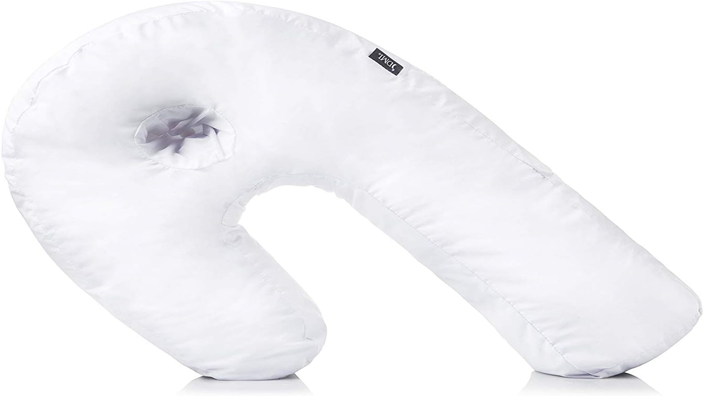Dealing with a frozen shoulder can turn your nights into restless experiences, and we all know that prolonged sleeplessness isn’t exactly a friend to our well-being. According to PhysioPedia, around 70% of women are facing this issue. Also, approximately 20% of diabetic patients are suffering this pain. But fear not. You only need to know How To Sleep With A Frozen Shoulder.
In this article, we share how to cure a frozen shoulder quickly with some at-home remedies that might help speed up your affected shoulder recovery. We get it – there’s no universal fix, but don’t worry, we’ve got you covered with many options to bring relief. So, keep reading!
Table of Contents
- Quality Sleep Advice for Frozen Shoulders
- Reasons, Symptoms & Stages Of A Frozen Shoulder
- Stages Of Frozen Shoulder
- Contoured Support Side Sleeper & Body Pillow - Pregnancy Pillow For Neck, Back, Hip, Joint Pain, Sciatica Relief - Firm Full Body Pillow With Removable Washable Cover
- How to Cure Frozen Shoulder Quickly At Home?
- Ways To Cure Frozen Shoulder
- Ease Morning Stiffness With These Strategies
- Frequently Asked Questions
- Conclusion
Quality Sleep Advice for Frozen Shoulders
If your shoulder is frozen and you want to enhance your sleep quality, try lying on the side that isn’t affected. Hug a pillow close to your body while you do this. This should help align your shoulders. But why do we call it a frozen shoulder? Frozen shoulder, also called “adhesive capsulitis,” is a condition causing shoulder pain and stiffness.
It’s quite common, affecting around 2-5% of people sometime in their lives, and more likely to trouble women and individuals aged 40 to 70. A frozen shoulder is believed to stem from inflammation and scarring in the shoulder's joint capsule. The shoulder capsule is a thin tissue layer stabilizing the joint. It is surrounded by connective tissue. When this capsule gets inflamed and scarred, it restricts movement.
Reasons, Symptoms & Stages Of A Frozen Shoulder
Certain factors increase the chances of developing a frozen shoulder. These include Dupuytren’s contracture, Parkinson’s disease, and heart attacks. Other research suggests that occupational factors play a role, too. People working at high altitudes, dealing with heavy objects, and doing manual labor are more prone to developing frozen shoulders. Moreover, numerous factors could make women more susceptible to frozen shoulder development. It could be due to hormonal issues during menopause.
Another angle could be that women often have health conditions linked to frozen shoulders or even neck pain, like diabetes or thyroid issues. Plus, women might be more into activities that increase the chance of a frozen or stiff shoulder, such as overhead tasks or making the same moves over and over. The symptoms of a frozen shoulder show up over a few months. It usually starts with shoulder pain that can range from mild to intense. Nighttime and movement tend to worsen the pain. As things progress, the shoulder gets stiffer.
Stages Of Frozen Shoulder
Raising the arm overhead, reaching behind your back, or even dressing becomes hard or impossible. There are 4 stages of frozen shoulder:
1- Freezing Stage
This is the first phase. It brings shoulder pain and stiffness, often worse at night or when moving the shoulder. The shoulder’s range of motion might decrease at this point.
2- Frozen Stage
The second phase follows, marked by continued stiffness but often less pain. Raising the arm, reaching behind, or getting dressed can be tricky due to the stiffness.
3- Thawing Stage
The third phase sees some improvement in movement. You’ll notice some signs that the frozen shoulder is starting to thaw, such as the shoulder remaining somewhat stiff but becoming easier to move. Pain might also get better during this stage.
4- Resolution Stage
The final stage is the fourth one. It signifies full recovery. The shoulder returns to its complete range of motion and strength, and the pain disappears. Different people experience these stages for varying lengths of time. Typically, the freezing stage lasts 2 to 9 months, the frozen stage lasts 4 to 12 months, the thawing stage lasts 5 to 18 months, and the resolution stage lasts 6 to 24 months.
You Might Also Like:How To Lower SHBG
Contoured Support Side Sleeper & Body Pillow - Pregnancy Pillow For Neck, Back, Hip, Joint Pain, Sciatica Relief - Firm Full Body Pillow With Removable Washable Cover
About This Item
- Enhance Your Sleep Experience with a Plush Polyester Pillow
- Indulge in the plush comfort of this pillow, filled with 100% polyester fiberfill and wrapped in a cooling cotton blend case. The ergonomic ear pocket ensures continuous airflow, providing unmatched comfort all night without the need to flip the pillow.
- It is crafted for side sleepers and is ideal for use during pregnancy; the U-shaped design cradles the entire body, offering support to the head, neck, arms, and hip. The huggable design adds an extra layer of comfort, promoting a sense of security for a night of deep, refreshing sleep.
- Compact and versatile, this pillow becomes your go-to travel companion. Whether on planes, trains, hotel rooms, or long car rides, enjoy the comfort wherever you go.
- Product Dimensions: 30" x 20" x 6". Machine washable for easy care. Simply remove the cotton blend cover and toss it in the wash!
How to Cure Frozen Shoulder Quickly At Home?
There are no frozen shoulder cures in 1 minute. Usually, it takes about a year and a half for this condition to get better on its own. However, there are several ways to help make the recovery process faster, such as:
Change Your Sleeping Posture
Other than lying on the unaffected side, you can also sleep on your back if that is your ideal position for sleeping. Keep your arms straight down by your sides to avoid putting too much stress on your shoulders, neck, and arms. This position lines up your spine well, letting your body unwind, release tension, and recover while you sleep. Another way to do this is to lie similarly on your back. But this time, with your arms either under your head or stretched above it.
This posture is helpful because it eases pressure on the sore muscles and tendons. Placing a pillow beneath your knees can make it comfier for longer periods. Remember to keep your head facing the ceiling to avoid twisting your neck, which could worsen the issue over time. Though, this position might only work for some for a whole night’s sleep.
Use a Support Pillow
Placing a pillow between your arms can be a helpful trick while sleeping on the unaffected side. This supports the frozen shoulder, preventing it from shifting during the night. Also, consider getting a good head pillow with solid neck support. This keeps your head and neck aligned with your spine, lowering strain on the neck and the sore shoulder.
Another pillow you can get is the one that supports the entire body. It will help the injured shoulder, easing pressure on different parts of the affected area. You can also put it between your knees for extra support. If you’re a side sleeper, the best pillow for a frozen shoulder is a U-shaped one or one with side wings. Or get a medium loft pillow to keep your spine aligned if sleeping on your back is your ideal position. If you are in extreme pain, you need firm support. A memory foam or a gel pillow can be helpful in that regard.
Frozen Shoulder Diet
Although your diet doesn’t cure the frozen shoulder directly, eating nutritious fruits, veggies, and whole grains can help lower inflammation and boost your overall well-being.
Warm Compress
Putting a heat compress on your shoulder can get the blood flowing and ease the pain and stiffness. Grab a heating pad, hot water bottle, or a warm towel, but make sure you wrap it up in a cloth so you don’t burn your skin. Keep the compress on your shoulder for 15 to 20 minutes a few times daily.
Physical Therapy
You can learn exercises to stretch and strengthen shoulder muscles at home. Or take the help of a physical therapist to enhance shoulder motion and ease pain.
Pain Relievers
Everyday pain meds like ibuprofen or acetaminophen can help. In some cases, you might need stronger options like opioids.
Corticosteroid Shots
Injections can lower pain and inflammation, but only a doctor should manage them due to potential side effects. Frozen shoulder pain can be unbearable, and the above remedies might not cure it. In such a scenario, you’ll have to get proper treatment. Your doctor may recommend:
Hydrodilatation
This involves injecting sterile water into the shoulder joint to stretch the capsule and improve movement.
Shoulder Manipulation
Your doctor will manipulate the shoulder under anesthesia to break up scar tissue and enhance the range of motion.
Surgery
This is rarely needed. It could be considered if other treatments fail. The procedure involves removing scar tissue from inside the shoulder joint. It is great for the rotator cuff injury as well.
Ways To Cure Frozen Shoulder
| Ways | Description |
|---|---|
| Sleeping Posture | Back sleeping with arms down or over your head for proper spine alignment and reduced shoulder, neck, and arm pressure. |
| Support Pillow | Use a pillow between arms or opt for a body pillow to support a frozen shoulder, maintaining neck and spine alignment. |
| Frozen Shoulder Diet | Though not a direct treatment, a healthy diet with fruits, vegetables, and whole grains can reduce inflammation and boost health. |
| Warm Compress | Apply a heat compress for 15-20 minutes multiple times a day to increase blood flow, reduce pain, and alleviate stiffness. |
| Physical Therapy | Engage in stretching and strengthening shoulder exercises at home or with a physical therapist for improved motion and relief. |
| Pain Relievers | Manage pain with over-the-counter options like ibuprofen or acetaminophen; opioids may be considered in extreme cases. |
| Corticosteroid Shots | Doctor-administered injections to ease pain and swelling, with potential side effects. |
| Hydrodilatation | Stretch the capsule by injecting sterile water into the shoulder joint. |
| Shoulder Manipulation | Under anesthesia, the doctor manipulates the shoulder to disrupt scar tissue formation and improve range of motion. |
| Surgery | Rarely needed; involves debridement of scar tissue inside the joint if other treatments fail. |
Ease Morning Stiffness With These Strategies
Morning shoulder stiffness is common due to inactivity during sleep. Start by taking a 10 to 15-minute warm shower to loosen up. Follow it with a pendulum swing exercise: lean forward, letting the affected arm hang down, and move it in a small circle.
Frequently Asked Questions
How Can I Stop My Frozen Shoulder From Hurting At Night?
You can stop your frozen shoulder from hurting at night by using a supportive pillow under your arm, and experimenting with different sleeping positions might help. Gentle stretches before bed can also ease stiffness. If pain persists, consider talking to your doctor about pain relief options.
How Do I Get Instant Relief From A Frozen Shoulder?
Instant relief might be tough, but a warm compress for about 15 minutes can help relax the muscles. Be cautious with any sudden movements and avoid overexertion.
What Not To Do With A Frozen Shoulder?
Avoid aggressive or forceful movements that can worsen the pain. Steer clear of heavy lifting or sudden jerking motions. And don’t skip out on gentle stretches and training, even if it’s uncomfortable.
Can Sleeping On One Side Cause A Frozen Shoulder?
While it’s not a direct cause of a frozen shoulder, consistently sleeping on one side might contribute to shoulder discomfort. It’s a good idea to switch up your sleeping positions to avoid potential strain.
Where Does A Frozen Shoulder Hurt The Most?
A frozen shoulder often brings the most pain when you try to move your arm, particularly when lifting or rotating it sideways. The outer part of your shoulder might ache the most.
What Ointment Is Good For Frozen Shoulder Pain?
Topical pain relief ointments with ingredients like menthol or capsaicin can provide temporary relief. But, they may not fully address the underlying issue. Consulting your doctor for appropriate treatment is advisable.
Conclusion
So, there you have it – the remedies for how to sleep with a frozen shoulder. Remember, finding the right sleeping position and using pillows for support can make a big difference in your comfort at night. Also, you have to keep this arm in a neutral position compared to your shoulder blade.
And if nothing cuts it, you might need surgery, but it’s rare, and you may get better with the abovementioned remedies. It might take some trial and error, but with a bit of patience, you can make those nights more restful despite the frozen shoulder discomfort.


























